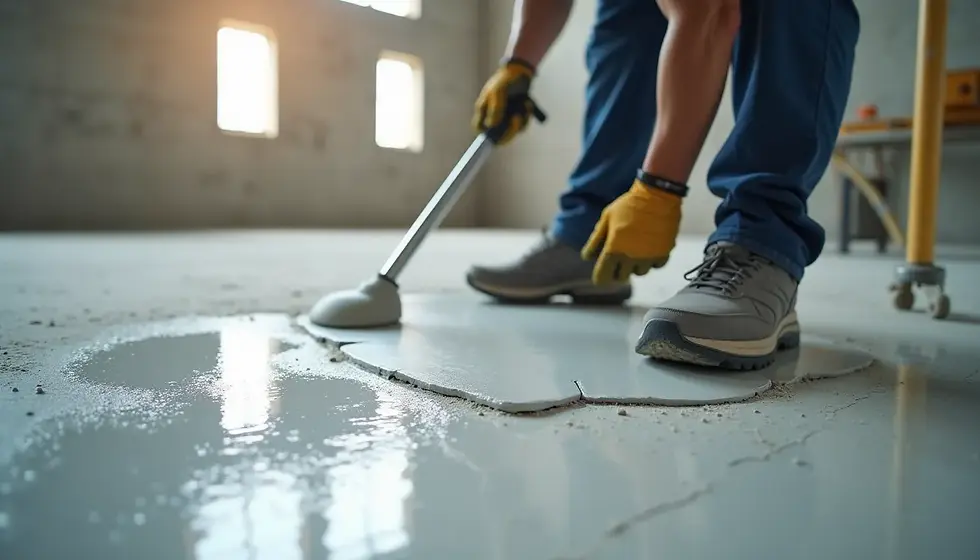What does paint and epoxy remover do to plastic?
- Mei-Lin Arora

- Sep 4
- 7 min read
Updated: Sep 13
If you’ve ever dripped stripper onto a plastic switch plate or thought, “eh, I’ll just clean this epoxy off that plastic bucket,” here’s the short version: most paint and epoxy removers soften, swell, haze, craze (fine crack), or outright melt many common plastics. That’s because the same powerful solvents that break the bond of cured paint/epoxy can also attack the polymer chains in plastics. ⚠️
Rule of thumb: if a remover is strong enough to dissolve cured coatings, it can absolutely damage plastic. Assume it will—then test to prove otherwise.
Below is a practical, step-by-step guide you can actually use—no chemistry degree required (though we’ll sprinkle in just enough science to keep you out of trouble).
If your slab shows hairlines, this dust-free method for epoxy concrete crack repair beats chiseling.

Quick answer: What does paint and epoxy remover do to plastic?
Most removers use aggressive solvents (e.g., ketones, chlorinated or aromatic solvents, NMP, strong alkalis) that penetrate plastics. The plastic absorbs the solvent, which can cause whitening/clouding, softening, swelling, warping, “crazing” (spider-web microcracks), or brittle cracking hours or days later. Some plastics (polycarbonate, polystyrene, ABS, acrylic/PMMA, PVC) are especially vulnerable; others (polyethylene and polypropylene) handle many solvents better—but not all. In other words: results vary by plastic, chemistry, temperature, and time.
The 60-second chemistry (so you know what you’re dealing with) 🧪
Why removers work on coatings: Coatings are long chains cross-linked to form a hard film. Solvents and/or alkalis in removers break or swell that network so you can scrape it off.
Why plastics suffer too: Plastics are… also long chains. When the solvent can dissolve or swell that particular polymer, you get softening and damage. When the solvent doesn’t fully dissolve it, you still can get environmental stress cracking (ESC): tiny cracks that grow under stress—even after the piece “looks” dry.
Regulatory context: Some of the strongest consumer paint strippers historically contained methylene chloride (dichloromethane). Because of acute fatalities, the EPA’s 2019 final rule removed consumer availability for paint/coating removal uses and restricted distribution. If you find an old can in the garage—don’t use it, especially indoors.
Health note (because your lungs matter): Methylene chloride is also a serious inhalation hazard; NIOSH has warned for decades about acute toxicity and long-term risk. Ventilate and use proper PPE with any stripper—yes, even “green” ones. CDC
Dry time dictates schedule, and this primer on how long enamel paint takes to dry helps you avoid tacky finishes.

Which plastics get wrecked (and which survive)?
Here’s the practical breakdown most DIYers need:
High-risk plastics (handle with extreme caution):Polycarbonate (PC / “Lexan”), acrylic (PMMA / “Plexiglas”), polystyrene (PS), ABS, PVC. These materials are frequently attacked by ketones (like acetone and MEK), aromatics (toluene/xylene), chlorinated solvents, and lacquer thinner blends. Expect whitening, crazing, and cracking—even from brief contact, especially under stress. Compatibility charts consistently flag acetone vs. polycarbonate as a “severe effect.”
Moderate-risk plastics:Nylon (PA), polyester (PET), acetal (POM/Delrin). They can survive some solvents but not others; alkaline paste strippers may also attack them. Always spot-test.
More resilient (but not invincible):Polyethylene (PE/HDPE) and polypropylene (PP) resist many solvents and are often used for chemical bottles. But they’re not bulletproof—concentration, heat, and time still matter. Use a compatibility database rather than guessing.
If you’re planning a garage makeover, this one-stop DIY epoxy flake garage floor guide shows prep that actually lasts.
“Chemical resistance” charts are general guides, not guarantees. Your exact outcome depends on concentration, temperature, load/stress in the part, and exposure time—four knobs that can turn “safe” into “oops.” Curbell Plastics
Step-by-step: the safest way to remove paint/epoxy from plastic (without ruining it)
Identify the plastic (if you can).Look for the resin code or markings (e.g., PP, HDPE, ABS, PC). If unknown, treat it like a high-risk plastic.
Read the product’s label/SDS before you even open it.If you see acetone, MEK, toluene/xylene, dichloromethane, NMP, or concentrated alkali—assume high risk for many plastics. The EPA/Federal Register page on methylene chloride explains why certain removers are now out of consumer circulation; take the hint and avoid legacy stock.
Start mechanical, not chemical.
Try warm soapy water, time, and elbow grease.
Use a plastic scraper, old credit card, or nylon brush.
A hair dryer/low heat gun can soften some paints (careful—heat warps thin plastics).
Move to mild solvents only if needed (spot-test first).
Isopropyl alcohol (IPA 70–91%): relatively gentle for many plastics; still test.
Mineral spirits (aliphatic): often safer than acetone on ABS/PC/PMMA; again, test.
Citrus (d-limonene) adhesive removers: can work, but some plastics still swell—test, test, test.Dab with a cotton swab in an inconspicuous area for 60–120 seconds, wipe, and wait 2–24 hours. If whitening, softening, or hairline cracks appear, stop.
Avoid the usual plastic killers unless you already know your plastic tolerates them.
Acetone / MEK / lacquer thinner → commonly haze/craze PC, PMMA, PS, ABS. Plastics International
Chlorinated solvents (e.g., dichloromethane) → powerful strippers, high plastic and health risk; consumer sales for paint removal are restricted for good reason.
Strong alkali paste/gel strippers → can saponify/etch certain plastics.
Work in short contact cycles. Apply the mildest method, wait a minute or two, scrape/lift gently, then rinse. Repeat. “Long soaks” dramatically increase damage risk.
Rinse and neutralize. After any chemical contact, wash with warm water and mild detergent, then rinse thoroughly and air dry.
Revive the surface (optional). If you get haze on acrylic, a dedicated acrylic polish may improve clarity. For PC/ABS, consider plastic restorer products. If crazed or cracked, replacement is the only truly safe fix.
If a label (or SDS) tells you “do not use on plastic,” believe it. The label is cheaper than a new headlight, window, or appliance bezel.
Real-world examples (so you know what to expect)
Acetone on polycarbonate: Often an immediate clouding followed by fine cracks—classic ESC behavior. Compatibility charts list “severe effect.”
“Eco” citrus remover on ABS: Can look fine for an hour, but the part turns chalky/soft overnight because the solvent diffused in. (Hence the advice to wait up to 24 hours after spot-testing.)
Mineral spirits on polypropylene: Frequently fine for brief contact (especially at room temp), but still confirm using a compatibility database first; PP isn’t immune to every solvent.
If a DIY paint job went sideways, fix odor fast with these proven methods for getting rid of spray paint smell without masking.
How to research your exact plastic (without guessing)
Check a compatibility database or chart for your plastic vs. the specific solvent. The free Cole-Parmer Chemical Compatibility Database is widely referenced by labs and industry and is easy to use. Cole-Parmer
Cross-check with a materials supplier’s chart (e.g., Curbell Plastics). Seeing the same rating from multiple sources reduces nasty surprises.
If you suspect polycarbonate, acrylic, ABS, or PS, err on the side of no strong solvents. The Plastics International chart specifically flags acetone and many lacquer thinner components as problematic for PC/PMMA.

Safer playbook for plastic parts (when you must remove paint/epoxy)
For fresh, uncured epoxy drips: Wipe immediately with isopropyl alcohol on a microfiber; do not scrub aggressively. If cured, try mechanical removal (careful scraping) before any solvent.
For latex paint smears: Warm soapy water, then IPA spot-cleaning. Avoid acetone/lacquer thinner on risk plastics.
For stubborn oil-based paint specks: Try mineral spirits with short contact and rapid rinse. If it blushes or softens—stop.
For unknown plastics: Assume high risk. Test IPA first. If that fails, consider professional help or accept the blemish; replacement may be cheaper than a ruined part.
Ventilation & PPE: Even “safer” solvents can be hazardous. NIOSH guidance exists for good reasons—use gloves rated for the solvent, eye protection, and airflow.
Patch days go smoother with this punchy walkthrough on how to touch up wall paint without flashing.
A note on “banned” or “old-school” strippers
If you stumble on older methylene chloride paint removers: don’t use them, especially in enclosed spaces. The EPA’s 2019 final rule removed consumer availability for paint/coating removal uses precisely because of acute fatalities; regulatory actions have continued reinforcing those restrictions. Dispose of old stock per local hazardous waste rules.
FAQs
In one sentence: what does paint and epoxy remover do to plastic?It softens, swells, hazes, or cracks many plastics because the same aggressive chemistry that breaks down coatings also attacks polymer chains.
Which plastics are most likely to be damaged?Polycarbonate, acrylic, ABS, PS, and PVC are frequent casualties; PE and PP are more solvent-tolerant but still not invincible—check a compatibility chart.
Is acetone safe on plastic?Not on many of the plastics you care about (PC, PMMA, PS, ABS). Expect clouding/crazing; compatibility charts rate acetone vs. polycarbonate as “severe effect.” Plastics International
What should I try first on paint smears over plastic?Warm soapy water, then gentle mechanical removal, then small IPA spot-tests with fast rinse. Keep contact times short.
Are “eco” strippers safe for all plastics?No. Citrus/terpene products can still swell certain plastics. “Green” doesn’t mean “plastic-safe.”
Why do cracks appear hours after cleaning?That’s environmental stress cracking—solvent uptake + internal stress + time. It can show up long after the surface looks dry. Curbell Plastics
Conclusion: what does paint and epoxy remover do to plastic (and what you should do instead)
Removers are designed to break tough coatings—and plastics are chemically similar enough that they often get caught in the crossfire. If you care about the plastic surface, assume damage until proven otherwise. Work mechanically first, use mildest solvents only after spot-testing, keep contact times short, and confirm compatibility with reputable charts. Your future self (and your wallet) will thank you. 🙂
When you’re considering painting exteriors, this straight-talk guide answers can you paint vinyl cladding and explains how to prep so it doesn’t peel.



Comments